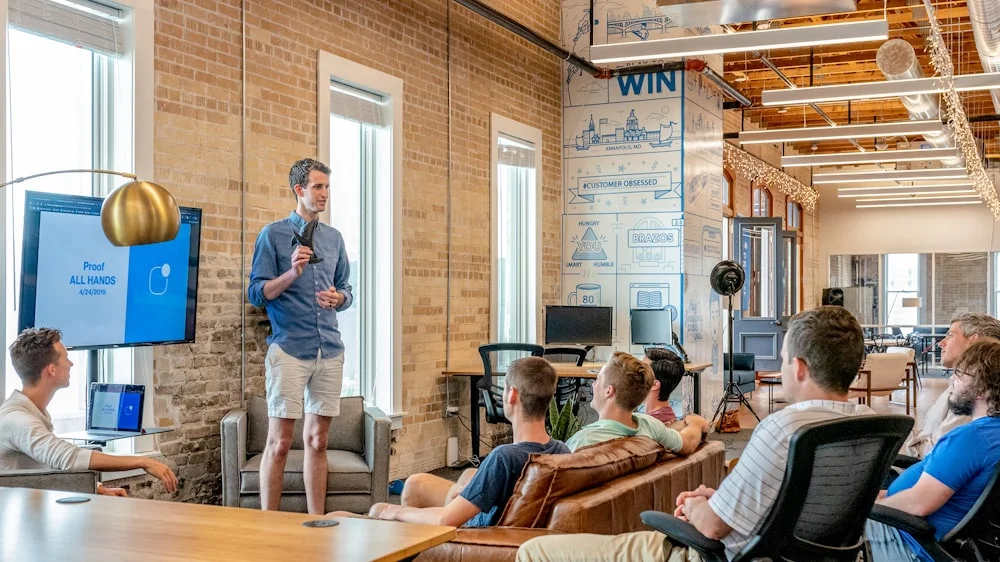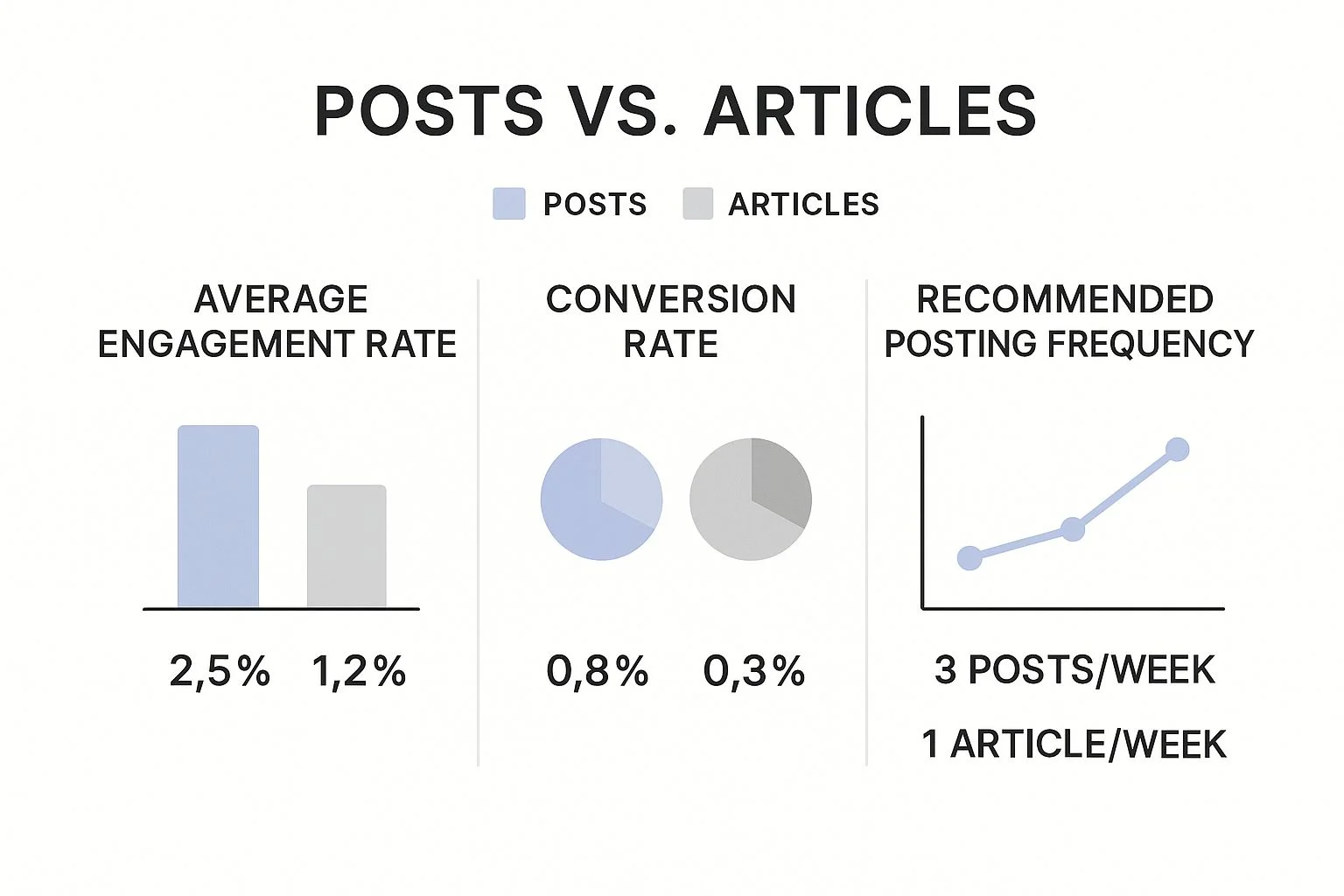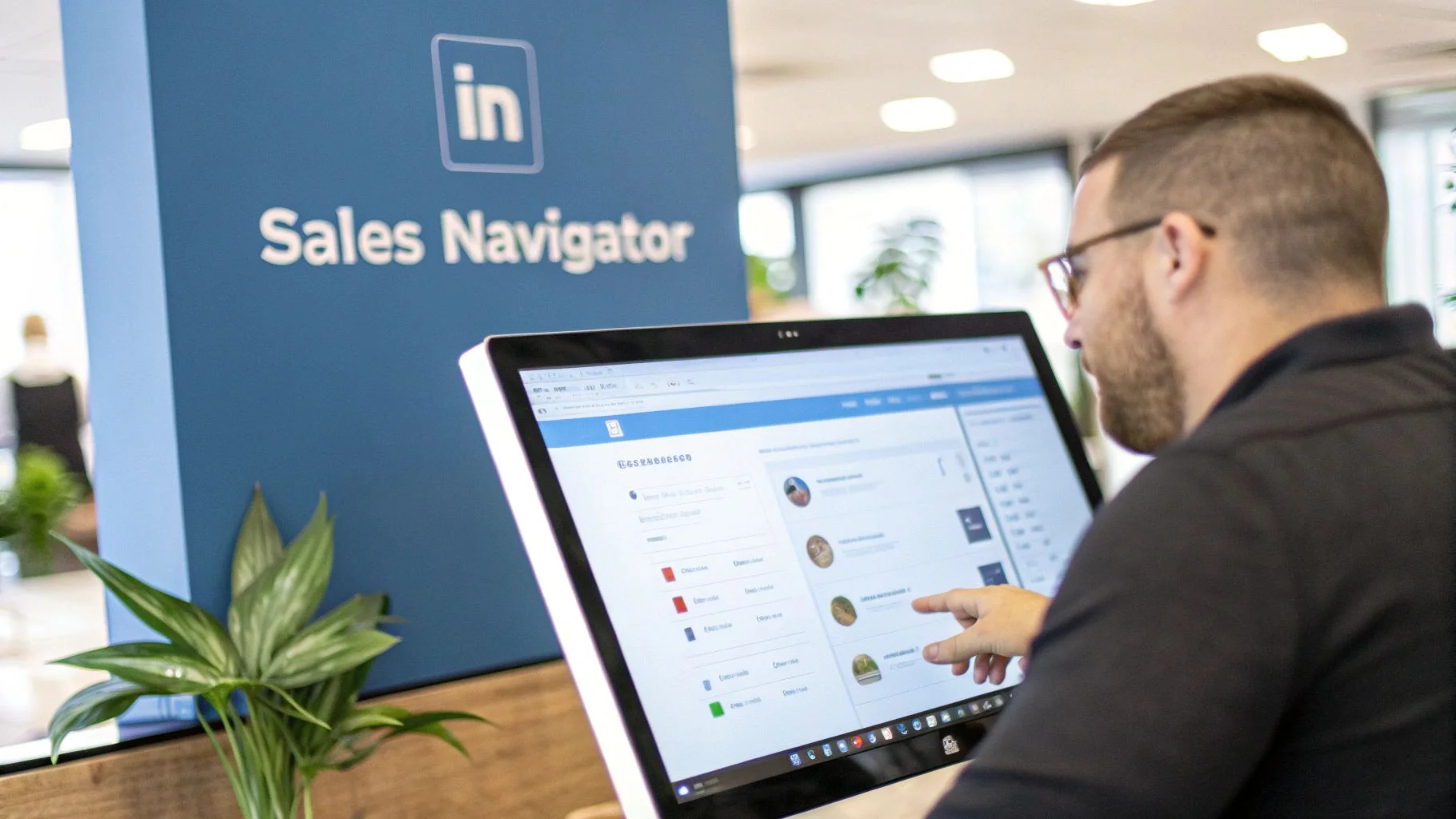A Guide to Social Selling on LinkedIn
Master social selling on LinkedIn. Build genuine relationships, establish expertise, and turn connections into sales conversations.

A Guide to Social Selling on LinkedIn
Let's be honest, the term "social selling" gets thrown around a lot. But what does it actually mean, especially on a platform like LinkedIn?
At its core, social selling is about playing the long game. It's the art of building real, genuine relationships with potential clients instead of hitting them with a cold pitch out of nowhere. You use the platform to find the right people, show them you know your stuff by sharing valuable content, and build a connection that eventually blossoms into a real sales conversation.
Think of it this way: it’s the difference between a cold call and a warm introduction. With social selling, you establish trust before you ever ask for anything.
Why Social Selling on LinkedIn Actually Works

It's time to ditch the old playbook. Aggressive cold calls and spammy, copy-paste messages just don't cut it anymore. Social selling isn't just a new tactic; it's a completely different way of thinking about B2B sales.
Traditional selling feels like shouting your pitch into a crowded room and just hoping someone—anyone—is listening. Social selling on LinkedIn, on the other hand, is like getting introduced by a mutual friend everyone trusts. That initial wall of skepticism? It’s already gone.
This approach turns selling from a high-volume numbers game into a thoughtful, relationship-first process. You stop being just another salesperson and start becoming a helpful advisor. When you consistently show up with value and expertise, you build the kind of trust that opens doors and starts real business discussions.
The Mindset Shift: From Selling to Solving
The real secret to social selling on LinkedIn is a simple but powerful change in perspective. Stop focusing on what you want to sell, and start focusing on what problems your audience needs to solve.
This "solving" mindset changes everything.
You listen more than you talk. You start paying attention to what your prospects are posting, the questions they're asking, and the pain points they're griping about in industry groups.
You give value first. Before you even think about asking for a meeting, you're sharing insightful articles, dropping helpful comments, and connecting people in your network who could benefit from knowing each other.
You build authentic connections. The goal isn't just to build a list of leads to bombard with automated messages. It's to create a genuine professional network.
Why does this work so well? Because today's B2B buyers are savvy. They do their own homework and have a low tolerance for being interrupted. In fact, over 70% of B2B decision-makers use social media to research products and services before they even think about buying.
By the time a potential buyer actually reaches out to a salesperson, they're often more than halfway through their decision-making process. Social selling lets you get in on that conversation from the very beginning.
LinkedIn Is the Perfect Playground
LinkedIn is uniquely built for this modern, more human approach to sales. It's a professional world where decision-makers are actively looking for solutions, insights, and industry knowledge. People are there for business, which makes them far more open to professional engagement than on any other platform.
When you consistently show up as a helpful resource, you become a familiar and trusted name. And when a need finally arises, you're not a stranger—you're the first person they think to call. That’s the real magic of social selling on LinkedIn: it turns your network into your most valuable sales asset.
Your LinkedIn Profile: The Foundation of Social Selling

Before you even think about sending a connection request or writing a post, we need to talk about your LinkedIn profile. Seriously. Think of it less like a CV and more like your personal sales page. It needs to do the heavy lifting for you, 24/7, by answering one simple question for every person who lands on it: “What’s in it for me?”
If your profile just lists your old jobs and responsibilities, you’re missing the entire point of social selling on LinkedIn. A truly client-focused profile flips the script. It’s not about what you’ve done; it’s about what you can do for them. Every single part of it—from your headline to your 'About' section—should be designed to build trust and show prospects you get their world.
This isn't about vanity. It's about strategy. A sharp profile pulls in leads and gives you instant credibility when you're the one reaching out. It's the bedrock of everything else you'll do.
Your Headline Is Your 24/7 Elevator Pitch
Your headline is the most valuable piece of real estate on your entire profile. It follows you everywhere you go on LinkedIn—in search results, comments, and connection requests. Most people just put their job title, like "Account Executive at ABC Corp." That tells people what you are, but it doesn't tell them what you do.
A powerful, client-focused headline nails this simple formula: I help [Your Target Audience] achieve [Their Desired Outcome] by [Your Method].
The Old Way: Sales Manager at TechSolutions
The Smart Way: I Help SaaS Founders Scale Revenue by Optimizing Their Sales Funnels
See the difference? The second one instantly grabs the right person's attention and screams value. It starts a conversation before you’ve even sent a message, positioning you as a problem-solver, not just another salesperson.
Ditch the Resume, Tell a Story in Your "About" Section
Your "About" section is where you get to be human. Please, ditch the corporate-speak and stop writing about yourself in the third person. Write like you talk. Let your personality come through.
Structure it like a mini-story that hooks your ideal client:
The Hook: Kick things off by calling out a big, frustrating problem your audience deals with every day.
The Empathy: Show them you get it. You've been there, you understand their struggles.
The Solution: Briefly explain how you solve that problem, focusing on your unique approach.
The Proof: Drop in a quick win—a key stat or a mini case study that shows you get results.
The Ask: End with a clear, no-pressure call to action. Invite them to connect or check out a helpful resource.
Think of your profile summary as a resource, not a resume. It should be so focused on the problems you solve that connecting with you feels like a smart business decision.
Your Headshot and Banner Make the First Impression
People are visual. Your profile picture and banner are the first things they’ll see, and they’ll form an opinion in a split second. A professional, high-quality headshot is non-negotiable. We're talking good lighting, a simple background, and a friendly, approachable look on your face.
And that banner image? It’s a huge missed opportunity if you leave it as the default blue graphic. Use that space to reinforce your value. It could be a client testimonial, your company's tagline, or a professional image that speaks to your industry. These visual cues build subconscious trust before anyone reads a single word.
With over 65 million decision-makers on LinkedIn, getting this right is critical. The platform is a massive source of traffic for B2B, and the data is clear: 78% of salespeople who use social selling outperform their peers who don't. A polished profile is always step one. If you want to learn how to grow your network effectively, it all starts here.
Putting Social Selling Tactics Into Action
Having a polished profile is just the starting line. Social selling on LinkedIn is an active sport, not a set-it-and-forget-it deal. It’s all about creating consistent, daily habits that turn your presence into a powerful lead-generation engine.
This isn't about aimlessly scrolling your feed. It’s a focused strategy built on three core actions that work together to get you noticed by the right people for the right reasons.
Think of it like building a house. Your optimized profile is the solid foundation. Now, it's time to build the structure—finding the right materials (prospects), assembling them with care (engagement), and securing the connections that hold it all together.
Let's break down how this works in the real world versus the old-school approach.
Traditional Selling vs Social Selling on LinkedIn
To truly grasp the shift, it helps to see the old and new methods side-by-side. The contrast is pretty stark.
| Tactic | Traditional Selling (The Old Way) | Social Selling on LinkedIn (The New Way) |
|---|---|---|
| Prospecting | Cold calling lists, buying email databases | Using advanced search filters and buying signals to find warm leads |
| First Contact | Unsolicited pitch email or call | Thoughtful comment on a prospect's post |
| Value Proposition | "Here's what our product does." | "I saw you're interested in X, here's an article that might help." |
| Relationship | Transactional and short-term | Relational and long-term |
| Goal | Close the deal | Build trust and become a known resource |
As you can see, social selling flips the script. Instead of interrupting prospects, you’re earning their attention.
Find the Right People Before They Find You
First things first: you need to identify your ideal prospects. Sending generic connection requests to random people is the digital equivalent of shouting into the void. It doesn't work.
You need to become a detective. Use LinkedIn’s powerful search tools to pinpoint decision-makers who are not just a good fit, but are also showing signs they might be ready to buy.
Mastering LinkedIn's search filters is your first move. Go beyond just job titles and industries. Use filters for company size, geography, and keywords in their profile to zero in on your list. If you're serious about this, LinkedIn Sales Navigator is non-negotiable. It offers advanced filters like "posted on LinkedIn in the last 30 days" or "changed jobs in the last 90 days"—these are powerful buying signals.
A person who just started a new role, for example, is often looking to make an impact and is more open to new solutions. That’s your cue. This is how your outreach becomes timely and relevant, not random.
Engage With Value First
Once you’ve found your target prospects, the impulse is to immediately connect and pitch. Don't do it.
The most effective social sellers operate on a simple principle: give, give, give, then ask. Your goal is to get on their radar as a valuable resource before you ever show up in their inbox.
This means actively and thoughtfully engaging with their content. A simple "great post!" is forgettable. A thoughtful comment that adds to the conversation, asks an insightful question, or shares a related resource? That gets you noticed for all the right reasons.
The goal of engagement isn't to go viral; it's to become a familiar, trusted name in your prospect's professional circle. When you consistently add value to their conversations, you're not a stranger when you finally reach out—you're a recognized peer.
A solid engagement strategy involves:
Leaving thoughtful comments: Go beyond generic praise. Add a new perspective, ask a follow-up question, or share a brief personal experience related to their post.
Sharing relevant content: Post articles, case studies, or insights that directly address the pain points of your target audience. This is how you position yourself as an expert.
Tagging people strategically: If you share a piece of content you know a specific prospect would find valuable, tag them with a note like, "Thought you might find this interesting given your recent post on [topic]."
This approach to social selling on LinkedIn really works. In fact, top-performing salespeople are 51% more likely to meet or exceed their quotas by using these strategies. Why? Because 61% of decision-makers say that content focused on their pain points has a major influence on their buying decisions—something you can read more about on TheCMO.com.
The image below really drives this point home, showing the difference in results between different types of posts.

The data is clear: shorter, more frequent posts tend to generate higher engagement and conversions. They're an efficient tool for your daily social selling routine.
Connect With Authenticity
Okay, so you’ve warmed up a prospect by engaging with their content a few times. Now it’s time to send that connection request.
This is where so many people mess up. The default, empty request is lazy. A message that immediately pitches your product is a guaranteed way to get ignored.
Your connection request note should be short, personalized, and focused on them, not you. The winning formula is to reference a shared interest or a recent interaction you had.
Here are a few proven ways to do it:
The "Common Ground" Request: "Hi [Name], I saw your recent post on [Topic] and really appreciated your perspective on [Specific Point]. I've been following your work for a bit and would love to connect."
The "Shared Group" Request: "Hi [Name], I see we're both members of the [LinkedIn Group Name]. I enjoyed the question you posed last week about [Topic] and wanted to connect with other experts in this space."
The "Content Appreciation" Request: "Hi [Name], I just finished reading your article on [Article Topic], and your advice on [Specific Tip] was incredibly helpful. Great work! Would be great to connect."
See what they all have in common? They're personal, they offer genuine praise, and there’s zero pressure. This authentic approach dramatically increases your acceptance rate and sets a positive tone for future conversations.
Of course, knowing what to post on LinkedIn is also a key part of this strategy, as it gives people a reason to accept your request in the first place.
By mastering these three actions—finding, engaging, and connecting—you create a repeatable system for turning your LinkedIn activity into real sales opportunities.
Building Influence with a Content Strategy

A sharp profile and smart outreach are your foundation, but the real engine of social selling on LinkedIn is your content.
Think of your content as your credibility in action. It’s how you prove you know your stuff, show your value, and pull the right audience toward you—all without sending a single cold message.
The goal isn't just to post random stuff. It's about consistently sharing genuinely useful insights that solve your audience’s biggest headaches. Get this right, and you'll flip the script from chasing leads to attracting them. People will start seeing you as the go-to expert, making them way more likely to knock on your door when they need help.
Lead with Value, Not a Sales Pitch
This is the golden rule of social selling content: give, don't ask. Lead with insight, not a pitch.
People are scrolling LinkedIn for ideas, solutions, and professional growth, not for another ad. Your content has to match that vibe.
Every single post should aim to help, teach, or inform. Share a lesson you learned the hard way, break down a new industry trend, or offer a practical tip your audience can use today. This simple shift frames you as a generous expert, not just another salesperson.
Your content should answer the questions your ideal clients are already asking themselves. When you consistently solve their problems in public, they'll trust you to solve their bigger problems in private.
This whole approach builds a massive foundation of trust. By the time you actually start a sales conversation, the prospect already sees you as a credible, helpful resource.
Choose the Right Content Formats
LinkedIn loves a good mix of content, and so does your audience. A balanced strategy keeps your feed from getting stale and helps you reach more people. Not every post needs to be a 1,000-word masterpiece; sometimes the simplest formats hit the hardest.
Here are a few formats that kill it for social selling:
Text-Only Posts: Short, punchy posts with a killer first line are amazing for starting conversations. They’re fast to write and easy for people to read on the fly.
Carousels (PDFs): These are perfect for breaking down complex ideas into simple, visual slides. They get people clicking to see what's next, which the algorithm loves.
Short Videos: Native video is a massive attention-grabber. Use it for quick tips, telling a story, or explaining something tricky in under two minutes.
Polls: Want instant engagement and a peek inside your audience's head? Polls are your best friend. Ask a simple question tied to your industry and watch the responses roll in.
The trick is to play around and see what your network actually responds to. Don't be afraid to experiment.
Get on a Consistent Schedule
Honestly, consistency beats frequency every time.
Posting once in a blue moon just doesn't work. You lose all momentum. A regular posting schedule keeps you top-of-mind and tells LinkedIn you’re a serious player.
Aiming for two to four high-quality posts per week is a great, sustainable target for most people. It's enough to stay visible without burning yourself out or spamming your network. Remember, two genuinely helpful posts are worth more than five generic ones.

While long-form articles are great for those deep-dive topics, your bread and butter will be shorter posts that drive daily engagement. You can even slice up one big article into a week's worth of smaller text posts or a carousel.
And one last thing: talk to the people who comment! Replying to comments—especially within the first hour—gives your post a huge visibility boost. It turns your post from a broadcast into a real conversation, building a genuine community around you.
For a deeper dive, check out our guide on building a winning LinkedIn content strategy.
How to Measure Your Social Selling Success
So, you're putting in the work—engaging, posting, and connecting. But how can you tell if your social selling on LinkedIn is actually moving the needle?
Likes and views feel good, but they don't pay the bills. Real success is measured by actions that lead to real business outcomes.
To know what's working, you have to shift your focus from vanity metrics to meaningful key performance indicators (KPIs). Think of it like a road trip. The number of songs you listen to is a fun stat, but the real measure of progress is how many miles you’ve covered toward your destination. In the same way, your LinkedIn metrics should track progress toward a sale.
This means digging deeper than surface-level engagement. It's about finding data that proves you're connecting with the right people and sparking valuable conversations. A data-driven approach is the only way to prove your ROI, fine-tune your tactics, and show the tangible business value of all your effort.
Key Metrics That Actually Matter
Ditching vanity metrics is step one. Stop obsessing over post views and start tracking the KPIs that are directly tied to sales activities. These are the numbers that paint a clear picture of your pipeline-building efforts.
Here are the core metrics you should be watching:
Connection Acceptance Rate: This tells you how well your personalized outreach is landing. A low rate might mean your profile needs a refresh or your connection messages aren't hitting the mark. Aim for an acceptance rate above 30% to know your targeting is on point.
Profile Views from Target Companies: Are the right people checking you out? LinkedIn lets you see which companies your profile viewers work for. If you see a steady stream of visitors from your ideal customer accounts, you know your content is attracting the right audience.
Qualified Conversations Started: This is one of the most important metrics, period. Track how many meaningful, two-way conversations you kick off each week that move beyond simple pleasantries. A qualified conversation is one where you start to uncover a potential need or opportunity.
Decoding the Social Selling Index
LinkedIn gives you a built-in scorecard to help you gauge your performance: the Social Selling Index (SSI). This score, from 0 to 100, measures how effective you are across the four key pillars of social selling. It’s a fantastic diagnostic tool for spotting exactly where you can improve.
Your SSI isn't just a number; it's a roadmap. It breaks down your performance into actionable categories, showing you exactly where your strategy is strong and where it's falling short.
Your SSI score is made up of four components:
Establishing Your Professional Brand: How complete and client-focused is your profile?
Finding the Right People: How effectively are you using search tools to identify prospects?
Engaging with Insights: Are you sharing valuable content and joining relevant conversations?
Building Relationships: How strong is your network and your process for making connections?
A score above 75 generally means you have a strong and consistent social selling routine. Checking your SSI regularly helps you stay on track and make targeted improvements to your daily habits. With LinkedIn's user base now topping 1.2 billion members, it’s the essential arena for B2B engagement, and all that activity is fertile ground for these strategies to pay off. You can find more details about LinkedIn's powerful user statistics on sproutsocial.com.
Got Questions About Social Selling? Let's Unpack Them.
Jumping into social selling on LinkedIn always brings up a few practical questions. Figuring out the landscape helps you set realistic expectations and build a strategy that actually works for you, not against you.
Let's tackle some of the most common things people wonder about when they're getting started.
How Much Time Does This Really Take?
One of the first concerns is always time. How much of it does this actually chew up?
The answer isn't about spending hours mindlessly scrolling. It's about focused, consistent effort. Committing just 20-30 minutes each day to targeted activities—like engaging with a handful of key prospects or sharing one insightful post—is enough to build serious momentum over time.
How Long Until I See Results?
This isn't an overnight thing. Unlike a cold call that gets an immediate "yes" or "no," social selling is all about building relationships and credibility. Think of it like planting a garden; you won't see a sprout the day after you plant the seeds.
You'll notice the small wins first, like higher connection acceptance rates and more people engaging with your posts. The tangible results, like qualified meetings booked directly from your efforts, typically start rolling in within two to three months of consistent activity. Patience is the name of the game here. You have to stick with it.
Social selling success isn't measured in days, but in the trust you build over weeks and months. It’s a long-term investment in your professional brand that pays off in warmer leads and shorter sales cycles.
Do I Need to Pay for LinkedIn Sales Navigator?
Look, you can absolutely start social selling with a free LinkedIn account. But if you're serious about this, Sales Navigator is a total game-changer. It gives you advanced search filters that let you pinpoint ideal prospects with incredible precision, saving you hours of manual digging.
Here's why it's so powerful:
Advanced Lead Filters: Zero in on people by company size, seniority level, recent job changes, and so much more. It's incredibly specific.
Lead Recommendations: The platform starts proactively suggesting relevant leads based on what you've saved. It does the hunting for you.
InMail Messages: You get a monthly stash of messages to reach people outside your network, which is a must-have for targeted outreach.
While it's not mandatory on day one, upgrading is a smart move once you've built a consistent routine. It turns your prospecting from a guessing game into a data-driven process, getting you to meaningful conversations—and ultimately, closed deals—much faster.
Ready to make your daily LinkedIn routine more efficient and impactful? Social Presence is the all-in-one tool designed to help you build meaningful connections and show up consistently without the grind. Streamline your engagement, generate thoughtful comments with AI, and track your progress effortlessly. Start saving time and building your brand with Social Presence today.